2. 吉林大学自然资源部东北亚矿产资源评价重点实验室, 长春 130061
2. Key Laboratory of Mineral Resources Evaluation in Northeast Asia, Ministry of Natural Resources, Changchun 130061, China
锆石具有较高的稳定性和抗风化性,是沉积地层中常见的重矿物。近年来,碎屑锆石U-Pb年代学研究在确定地层最大沉积时代及其物源等方面发挥了越来越重要的作用(Fedo et al., 2003;Liu et al., 2018b)。同时,锆石U-Pb年代学与原位Hf同位素分析的结合也成为示踪锆石源区、了解区域地壳演化与生长历史的重要手段(Gerdes and Zeh, 2006;Hawkesworth and Kemp, 2006;Zeh et al., 2007;Wan et al., 2011;Matteini et al., 2012;Liu et al., 2017a, 2018a, b;Priyatkina et al., 2020;Wang et al., 2020)。
地球早前寒武纪地壳生长过程一直是人们研究早期地球演化的核心问题。地球上前寒武纪地壳生长的峰期可能主要集中在3.6Ga、2.7Ga和1.8Ga (McCulloch and Bennett, 1994),但也有学者认为2.7Ga、1.9Ga和1.2Ga是全球大陆地壳的主要生长时间(Condie, 1998, 2000)。其中2.7Ga的构造热事件在全球主要克拉通上均有发现,代表了一次主要的地壳生长事件,表现为TTG岩系(英云闪长岩-奥长花岗岩-花岗闪长岩)和火山岩的形成。比如加拿大苏必利尔地区(Mortensen, 1993a, b;Beakhouse et al., 1999;Percival et al., 2001;Percival and Helmstaedt, 2004)、西加拿大地盾(Sandeman et al., 2006)、波罗的地盾(Bibikova et al., 2001, 2005;Halla,2005;Samsonov et al., 2005)、西格陵兰克拉通南部(Thrane,2002;Steenfelt et al., 2005)、南非和津巴布韦克拉通(Kröner et al., 1999;Poujol et al., 2003;Hofmann et al., 2004)以及西澳大利亚的Pilbara和Yilgarn克拉通等(Bateman et al., 2001;Blake,2001)都记录有2.7Ga的构造热事件。
华北克拉通经历了漫长而复杂的演化历史,在鞍山、冀东、辽北等地的基底岩石中保存着年龄为3.0~3.8Ga的古老岩石,表明古陆核的存在(Liu et al., 1992, 2017b;Wu et al., 2008;万渝生等,2009),中新太古代以这些古陆核为中心发生巨量陆壳增生形成微古陆块。华北克拉通被认为由数个微古陆块碰撞拼合而成并广泛分布有~2.5Ga的构造热事件(Zhai et al., 2000;Zhai,2011),在辽西、吉南、鲁西、冀东、河北阜平、山西五台山以及内蒙古固阳、大青山等地区都有这期岩浆活动的记录(Dong et al., 2012;任鹏等,2015;徐仲元等,2015;李鹏川等, 2016, 2018;Li et al., 2019b)。与世界其他主要克拉通不同,华北克拉通内~2.7Ga的岩浆活动只有零星记录,主要分布在胶东、鲁西、霍邱、赞皇、左权、武川-固阳等地(董晓杰等,2012;Wan et al., 2014;宋会侠等,2018;肖玲玲等,2019)。全岩Nd同位素和锆石Lu-Hf同位素的研究表明,华北克拉通新太古代晚期的岩石可能来自于中太古代晚期到新太古代早期地壳再循环,即强烈的~2.5Ga构造热事件使~2.7Ga的地壳岩石发生再循环而保留较少(Zhai, 2011, 2013, 2014;Wan et al., 2014)。因此,华北克拉通上应该也存在~2.7Ga和~2.5Ga两次地壳生长事件,而~2.5Ga的构造热事件不仅代表了华北克拉通一次重要的地壳生长过程(Wan et al., 2014),同时也标志着第一次克拉通化完成(Zhai, 2011, 2014)。除了这两次主要的地壳生长过程,华北克拉通前寒武纪是否存在其他阶段的地壳生长过程仍需要进一步探讨。
白云鄂博群是华北克拉通北缘分布的一套中新元古代沉积地层,前人对其进行了大量的碎屑锆石U-Pb定年工作,并对白云鄂博群的物源和沉积时限等问题进行了较深入的研究(马铭株等,2014;Zhong et al., 2015;Liu et al., 2017a;Li et al., 2019a)。作为华北克拉通北缘结晶基底上最古老的沉积盖层,白云鄂博群中的碎屑锆石记录了丰富的基底岩石信息,对这些碎屑锆石的年代学和Hf同位素研究,可以为该地区前寒武纪的地壳生长过程提供很好的制约。本文以白云鄂博群底部尖山组为研究对象,利用碎屑锆石U-Pb定年和Lu-Hf同位素分析,对该地层的沉积时限及物源区进行了限定,并综合前人研究对华北克拉通西部陆块北缘前寒武纪地壳生长过程进行了探讨。
1 区域地质背景华北克拉通是世界上最古老的克拉通之一(Zhai, 2013, 2014),一般认为它由东部陆块和西部陆块在约1.85Ga时沿中部造山带拼合而成(Zhao et al., 2000, 2004, 2008, 2011, 2012)(图 1a)。1.80Ga开始华北克拉通经历了广泛伸展过程,代表性的岩浆活动包括1.78Ga基性岩墙群和熊耳火山岩系(Peng et al., 2007;赵太平等,2007;Peng,2015)以及1.72~1.62Ga的非造山型岩浆岩活动(赵太平等, 2004, 2007; Zhang et al., 2007; Zhao and Zhou, 2009)。上述岩浆活动表明华北克拉通在中元古代经历了持续裂解过程(Lu et al., 2002;Zhai and Liu, 2003;Zhang et al., 2007;Zhai,2011;Zhai and Santosh, 2011; Zhai et al., 2015)。在这一裂解过程中,华北克拉通东部、北缘和南部分别形成了燕辽裂陷槽(Lu et al., 2008;Li et al., 2013)、狼山-渣尔泰山-白云鄂博裂谷系(Liu et al., 2014, 2018b;Zhong et al., 2015)以及熊耳裂陷槽(Zhao et al., 2003, 2004)。
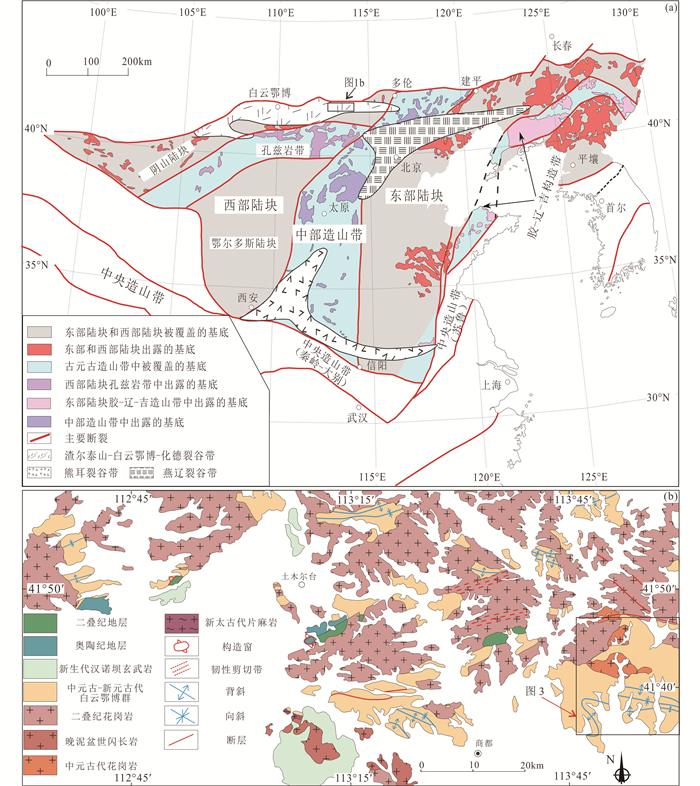
|
图 1 华北克拉通(NCC)前寒武纪基底构造划分(a,据Zhao et al., 2006, 2012;刘超辉和刘福来,2015修改)及商都地区地质简图(b,据Li et al., 2019a) Fig. 1 The Precambrian tectonic division of the North China Craton (NCC) (a, modified after Zhao et al., 2006, 2012; Liu and Liu, 2015) and geological sketch map of Shangdu area (b, modified after Li et al., 2019a) |
狼山-渣尔泰山-白云鄂博裂陷槽位于华北克拉通北缘中部,根据同位素年代学证据,该裂陷槽形成于中新元古代,该裂陷槽与燕辽、熊耳裂陷槽一起,可能为哥伦比亚超大陆裂解在华北克拉通上的响应(Zhao et al., 2004)。狼山-渣尔泰山-白云鄂博群裂陷槽中沉积有狼山群、渣尔泰山群、化德群和白云鄂博群。狼山群位于裂陷槽西侧,主要由二云母石英片岩、角闪大理岩、变质砂岩、云母石英片岩、结晶灰岩、碳质绢云母石英千枚岩等组成(Hu et al., 2014),该地层中较年轻的碎屑锆石年龄峰值为1187~810Ma。基于该地层中发现的~804Ma和~817Ma的变质酸性火山岩,狼山群被认为是新元古代裂谷中沉积物,而不同于渣尔泰山-白云鄂博裂谷系中的沉积地层(Hu et al., 2015)。渣尔泰山群分布在内蒙古中部阴山山脉中段的渣尔泰山地区,东至察哈尔右翼中旗红召乡红通巷(旧称马家店群),西至阿拉善左旗敖伦布拉格苏木东北的巴彦哈拉南(刘超辉和刘福来,2015)。渣尔泰山群主要由浅变质沉积岩组成,包括变砾岩、含砾长石石英砂岩、石英岩、白云岩、千枚岩和炭质千枚岩等(Li et al., 2007),自下而上该群可划分为书记沟组、增隆昌组、阿古鲁沟组和刘鸿湾组。书记沟组基性火山岩夹层锆石U-Pb年龄为1743±7Ma,表明渣尔泰山群沉积早于这一时间(Li et al., 2007)。渣尔泰山群中碎屑锆石年龄主要集中于1.8~1.9Ga和2.5Ga,从沉积序列上可将其与燕辽裂陷槽长城系进行对比(公王斌等,2016)。但也有学者提出渣尔泰山群物源主要来自华北克拉通内部,根据碎屑锆石年龄特征便将其与长城系完全对比是不恰当地(Liu et al., 2018b)。位于渣尔泰山群东侧的化德群主要分布在化德、商都、康保和太仆寺旗一带,总体上呈北东东向分布(刘超辉和刘福来,2015),是一套浅变质或未变质的沉积岩系,主要由砂岩、杂砂岩、长石砂岩、泥质岩、钙硅酸盐岩和灰岩等组成,有些经历了低级变质作用而成为石英岩、片岩、千枚岩、板岩、透辉岩和大理岩,部分层位含有低品位赤铁矿和褐铁矿(胡波等,2009)。化德群中碎屑锆石主要有2530Ma、1837Ma、1718Ma、1575Ma、1508Ma和1360Ma等几个年龄峰值(胡波等,2009;Liu et al., 2014),其顶部三夏天组可与白云鄂博群白音宝拉格组、渣尔泰山群刘洪湾组和燕山地区蓟县剖面下马岭组对比(Liu et al., 2018b)。
白云鄂博群以白云鄂博矿区附近为典型出露地,向东可到锡林郭勒盟南部化德县,向西可达达尔罕茂明安联合旗熊包子等地(刘超辉和刘福来,2015)。白云鄂博群南部出露有华北克拉通新太古代基底(Zhang et al., 2014;Wang et al., 2015;Ma and Zhong, 2018)以及中元古代孔兹岩系(Santosh et al., 2007;Jiao et al., 2013;马铭株等,2015)。在地层层序上,研究区内蒙古商都地区白云鄂博群可与东侧化德群相对比,本文依据近年来在研究区内进行的区域地质调查结果(吉林大学地质调查研究院,2015①),暂将这一套中新元古代地层称为白云鄂博群。研究区白云鄂博群自下而上可分为长城系都拉哈拉组(Chd)、尖山组(Chj),蓟县系哈拉霍疙特组(Jxh)、比鲁特组(Jxb),青白口系白音宝拉格组(Qbby)、呼吉尔图组(Qbhj)(内蒙古自治区地质矿产局,1991)(图 2)。都拉哈拉组以碎屑岩为主,主要岩性为变质含砾石英砂岩、变质砂岩等,地层内可见发育水平层状构造及交错层理等原生层状构造。该组中获得的最小碎屑锆石U-Pb加权平均年龄有1827Ma (马铭株等,2014)、1822Ma (Zhong et al., 2015)、1809Ma(Zhou et al., 2018)、1810Ma (Li et al., 2019a)和1871Ma (胡波等,2009)。尖山组以绢云千枚岩、变质粗砂岩、变质长石石英砂岩为主,局部变形强烈的地方发育片岩,该组中获得的最小碎屑锆石U-Pb年龄在1847~1716Ma(Zhong et al., 2015;Zhou et al., 2018)。哈拉霍疙特组为一套砂砾岩夹砾岩、变质细砾岩、深灰色石英大理岩、灰白色细晶灰岩,该组中获得的最小碎屑锆石U-Pb年龄有1710~1834Ma以及1513Ma (Zhong et al., 2015;Liu et al., 2017a;Li et al., 2019a)。比鲁特组其岩性以绢云千枚岩为主,是白云鄂博群中的软弱层,在地质演化过程中遭受了较高程度的变形改造,褶皱发育,该组中最小的碎屑锆石U-Pb年龄有1387Ma、1561Ma和1777Ma (Liu et al., 2017a;Zhou et al., 2018;Li et al., 2019a)。白音宝拉格组岩性为灰白色中厚层石英岩、变质石英岩,该组岩性与厚度稳定,发育有波痕、斜层理等原生层理构造,前人在该组中获得了1247Ma和1251Ma的最小碎屑锆石U-Pb年龄(Zhou et al., 2018;Li et al., 2019a)。呼吉尔图组岩性以藻纹层粉晶灰岩、绢云母板岩、粉砂质板岩和绿帘绿泥钠长阳起片岩等为主,其中最小的碎屑锆石U-Pb年龄在1116~1156Ma之间(Liu et al., 2017a;Li et al., 2019a)。
① 吉林大学地质调查研究院. 2015. 1/25万集宁市(K49C003004)幅区调修测报告
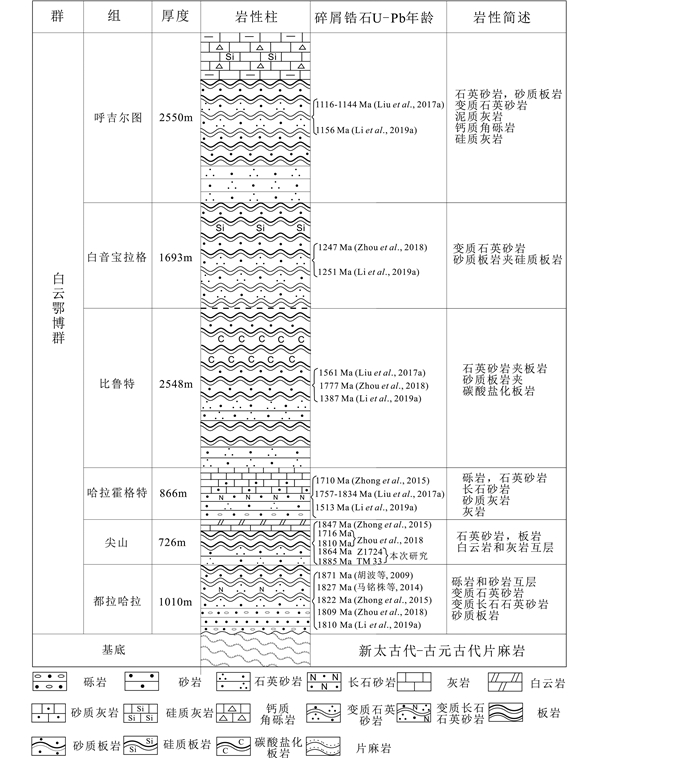
|
图 2 白云鄂博群地层序列及岩性(据Zhong et al., 2015;Liu et al., 2017a;Li et al., 2019a修改) Fig. 2 The sequence stratigraphic frame of the Bayan Obo Group (modified after Zhong et al., 2015; Liu et al., 2017a; Li et al., 2019a) |
本文2个样品均采自内蒙古商都地区北东白云鄂博群底部尖山组(图 1b、图 3)。样品TM33为白云母石英片岩,采自尖山组中部(采样坐标:41°41′18″N、113°57′12″E),细粒鳞片粒状变晶结构,片状构造(图 4 a,b)。主要矿物有黑云母(5%),白云母(25%)和石英(70%)。黑云母,片状,粒径0.2~0.5mm,浅褐色-深褐色多色性,干涉色二级;白云母,片状,粒径0.3~0.6mm,干涉色二级,黑云母和白云母定向排列形成片理;石英,粒状,粒径0.2~0.5mm,一级灰白干涉色,部分颗粒受构造变形影响,具有波状消光特征。
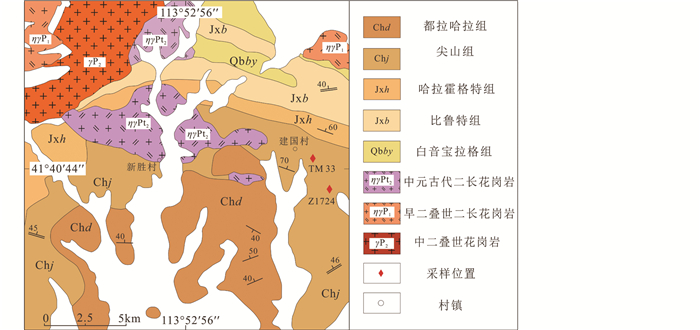
|
图 3 区域地质简图示TM33和Z1724采样位置 Fig. 3 The geologic sketch map showing sampling locations of TM33 and Z1724 |

|
图 4 TM33和Z1724野外及显微镜下照片 (a)TM33白云母石英片岩野外露头照片;(b)TM33镜下照片,白云母定向构成片理S1;(c、d)Z1724二云母石英片岩野外露头照片. Qtz-石英;Ms-白云母 Fig. 4 Representative field photos and photomicrograph for TM33 and Z1724 (a) the photo of outcrop for mica quartz schist (TM33);(b) the photomicrograph for TM33, the oriented mica form foliation S1; (c, d) the photos of outcrop for two-mica quartz schist (Z1724). Qtz-quartz; Ms-muscovite |
样品Z1724为二云母石英片岩,也采自尖山组中部(采样坐标:41°39′40″N、113°58′38″E),层位上位于样品TM33之下,细粒鳞片粒状变晶结构,片状构造(图 4 c,d)。主要矿物有黑云母(15%),白云母(20%)和石英(65%)。黑云母,片状,0.3~0.5mm,多色性明显,干涉色二级;白云母,片状,粒径0.4~0.6mm,二级干涉色,同时片理也由黑云母和白云母定向排列而成;石英,粒状,粒径0.2~0.5mm,一级灰白干涉色,部分颗粒具有波状消光。根据岩相学特征判断,2个样品原岩均为碎屑岩,样品中黑云母+白云母+石英的变质矿物组合表明该碎屑岩应该经历了绿片岩相变质作用。
3 测试方法 3.1 锆石LA-ICP-MS U-Pb测年锆石单矿物分选由河北省廊坊市科大岩石矿物分选技术服务有限公司完成,用锷破机将样品粉碎到合适粒度,用淘砂盘淘洗出重矿物后再进行磁选,最后在实体显微镜下挑选出锆石。锆石制靶、阴极发光(CL)、透射及反射照相由北京锆年领航科技有限公司完成。锆石U-Pb测年在吉林大学东北亚矿产资源评价自然资源部重点实验室利用LA-ICP-MS分析完成。激光剥蚀系统为德国COMPEx公司生产的GeoLasPro型193nm ArF准分子激光器,采用直径32μm、频率7Hz的激光束斑进行样品分析。与激光器联用的是Agilent 7900型ICP-MS仪器,采用He作为剥蚀物质的载气(Eggins et al., 1998;Jackson et al., 2004)。仪器最佳化采用美国国家标准技术研究院研制的人工合成硅酸盐玻璃标准参考物质NIST610,采用91500标准锆石外部校正法进行锆石原位U-Pb分析,具体实验测试过程参见Yuan et al. (2004)。用ICPMASDATACALL软件计算同位素比值和207Pb/206Pb、206Pb/238U、207Pb/235U的年龄值(Liu et al., 2010),采用Andersen (2002)的方法对结果进行普通铅校正,最后利用Isoplot程序计算其年龄。
3.2 锆石Hf同位素测定锆石Hf同位素分析在中国地质调查局天津地质调查中心同位素实验室LA-MC-ICPMS上完成。使用仪器为Thermo Fisher Neptune型多接收电感耦合等离子体质谱仪(MC-ICP-MS)和193nm氟化氩准分子激光器(NEW WAVE193nm FX),分析方法见耿建珍等(2011)。采用静态信号采集模式,背景采集时间30s,积分时间为0.131s,采集200组数据,总计约0.5min。激光能量密度为10~11J/cm2,频率为8~10Hz,束斑直径为35μm。采用179Hf/177Hf=0.7325(Patchett and Tatsumoto, 1981)对Hf同位素比值进行指数归一化质量歧视校正,采用173Yb/172Yb=1.35274(Chu et al., 2002)对Yb同位素比值进行指数归一化质量歧视校正。计算参数如下:176Lu衰变常数为1.876×10-11a-1,球粒陨石的176Hf/177Hf和176Lu/177Hf比值分别为0.0332和0.282772,现今亏损地幔的176Hf/177Hf为0.28325。
4 测试结果 4.1 锆石LA-ICP-MS U-Pb年代学2个样品的锆石LA-ICP-MS U-Pb测年数据见表 1。样品TM33中的锆石呈柱状或粒状,粒径在100~150μm,中等磨圆,显示搬运特征。在CL图像上,少部分锆石环带不明显,颜色较深,显示出变质锆石的特点;大部分锆石可见韵律环带,但是CL图像上显示其也经受了轻微重结晶作用改造(图 5)。Th/U比值0.06~1.23,并主要集中在0.15~0.6之间,表明既有岩浆锆石,也有变质锆石,并且岩浆锆石可能经受轻微重结晶作用,导致Th/U比值降低,这与CL图像上显示的特征一致。在80颗锆石上获得了70个谐和度在90%~105%之间的数据点,在锆石U-Pb谐和图上部分数据点位于谐和线之下,表明有轻微铅丢失,可能与锆石变质重结晶有关(图 6a)。70个碎屑锆石的207Pb/206Pb年龄范围在1872~2785Ma之间,并集中于1872~2100Ma (n=64),具有1960Ma和2000Ma两个峰值(图 6b)。同时,该样品谐和线上最年轻的一组锆石的加权平均年龄为1885±16Ma(n=3,MSWD=0.92)(图 6a)。
|
|
表 1 碎屑锆石LA-ICP-MS锆石U-Pb测年数据 Table 1 LA-ICP-MS detrital zircon U-Pb data |

|
图 5 典型锆石CL图像 实线圈为年龄位置,虚线圈为Hf同位素打点位置,括号中为对应年龄的εHf(t)值 Fig. 5 Representative zircon cathodoluminescence (CL) images The solid circles is the position of ages, the spotted circles are positions of Lu-Hf analysis, the εHf(t) values are in the brackets |
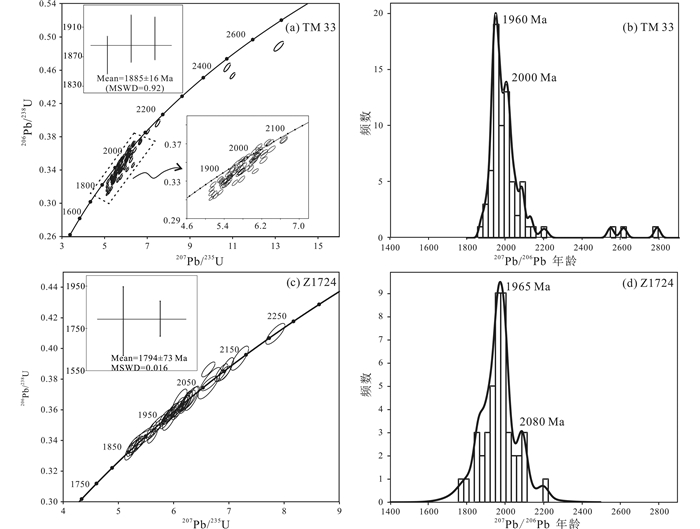
|
图 6 碎屑锆石U-Pb年龄谐和图、加权平均年龄及207Pb/206Pb年龄频率分布直方图 Fig. 6 Detrital zircon U-Pb concordia diagram, weighted average ages and binned frequency histograms of 207Pb/206Pb ages for the two samples |
样品Z1724锆石呈柱状或粒状,粒径在100~120μm,弱到中等磨圆,具搬运特征。在CL图像上,大部分锆石环带不明显,锆石核部阴极发光弱,颜色较深,显示出变质锆石的特点(图 5),Th/U比值0.14~2.34。在60颗锆石上获得了44个谐和度在90%~105%之间的数据点,207Pb/206Pb年龄范围在1784~2200Ma之间,具有1965Ma和2080Ma两个峰值年龄(图 6d)。该样品给出的谐和线上最年轻一组锆石的加权平均年龄为1794±73Ma(n=2,MSWD=0.016)(图 6c)。
4.2 锆石Hf同位素2件样品(TM33、Z1724)的锆石原位Hf同位素测试结果显示大部分锆石的176Lu/177Hf小于0.002 (表 2),表明锆石中放射性成因的176Hf积累较少。2件样品中的fLu/Hf平均值分别为-0.97和-0.98,小于镁铁质地壳的fLu/Hf (-0.34)和硅铝质地壳的fLu/Hf (-0. 72)(Amelin et al., 1999),因此二阶段模式年龄更能反映其源区物质从亏损地幔中被抽取的时间。采用平均地壳176Lu/177Hf比值0.015,利用相关计算公式计算各样品的εHf(t)、tDM1和tDM2。
|
|
表 2 碎屑锆石Lu-Hf同位素分析结果 Table 2 Detrital zircon Lu-Hf isotope data |
样品TM33中22颗锆石对应的22个分析点的176Hf/177Hf比值在0.281044~0.281724之间(平均值为0.281593)。其中1个点(TM33.9) εHf(t)为较低的负值(-17.6),对应较老的Hf同位素二阶段模式年龄(tDM2)(4386Ma)。其余21个点εHf(t)在-2.6~7.9之间(平均值为2.2)(图 7a),Hf同位素二阶段模式年龄(tDM2)变化范围在2240~3095Ma之间(除1个测点为4386Ma)。样品Z1724中22颗锆石对应的22个分析点176Hf/177Hf比值在0.281446~0.281680之间(平均值为0.281591),εHf(t)在-5.4~3.2之间(平均值为0.3)(图 7b),Hf同位素二阶段模式年龄(tDM2)变化范围在2584~3203Ma之间(平均值为2801Ma)。

|
图 7 白云母石英片岩(TM33)(a)和二云母石英片岩(Z1724)(b)碎屑锆石年龄- εHf(t)图解 亏损地幔(DM)、球粒陨石及平均地壳(CHUR)演化线据Bitchert-Toft and Albarède, 1997;Griffin et al., 2000, 2002 Fig. 7 The age vs. εHf(t) diagrams for detrital zircons of muscovite quartz schist (TM33) (a) and two-mica quartz schist (Z1724) (b) The evolution lines of DM, CHUR and Average Crust are after Bitchert-Toft and Albarède, 1997;Griffin et al., 2000, 2002. DM-depleted mantle; CHUR-chondrite uniform reservoir |
前人对白云鄂博群的沉积时间存在不同的认识,争议的焦点在其沉积时间到底是早古生代还是中新元古代(孙淑芬,1992;谭励可和史铁铮,2000;周志广等,2016)。碎屑锆石年龄可以给出地层沉积下限,因此基于新获得的碎屑锆石年龄数据以及前人研究成果,本文对白云鄂博群尖山组沉积时限进行了探讨。
本文2个样品给出的尖山组碎屑锆石年龄范围在1784~2785Ma之间,样品Z1724给出的谐和线上最年轻一组锆石的加权平均年龄为1794±73Ma(n=2, MSWD=0.016)。前人发表的尖山组碎屑锆石最小年龄有1810Ma(Zhou et al., 2018)、1847Ma(Zhong et al., 2015)等,之所以在同一个层位获得的最小年龄有所不同,可能和采样位置不同有关。结合前人数据结果,可以推断尖山组沉积时间应该晚于1800Ma。前人从尖山组之下的都拉哈拉组中获得的碎屑锆石最小年龄有1827Ma(马铭株等,2014)、1822±9Ma(n=3,MSWD=0.72)(Zhong et al., 2015)、1809±9Ma(n=3,MSWD=0.72)(Zhou et al., 2018)和1810±32Ma(n=6,MSWD=0.25)(Li et al., 2019a),表明都拉哈拉组也应该在1800Ma之后沉积。都拉哈拉组给出的最小加权平均年龄和尖山组误差范围内一致,并且两个地层组中碎屑锆石年龄峰值相近,可能表明这两个组具有相同的物源区(图 8)。结合侵入都拉哈拉组中年龄为1670±14Ma的辉长岩(周志广等,2016)以及全岩207Pb-206Pb等时线年龄为1649±45Ma的沉积碳酸盐岩(杨奎锋等,2012),可以将白云鄂博群尖山组的沉积时代进一步限定在1800~ 1650Ma之间,表明白云鄂博群尖山组于中元古代早期沉积。

|
图 8 白云鄂博群都拉哈拉组和尖山组碎屑锆石207Pb/206Pb年龄统计分布直方图 数据来自Zhong et al., 2015;Liu et al., 2017a;Zhou et al., 2018;Li et al., 2019a及本文 Fig. 8 The binned frequency histograms of 207Pb/206Pb ages for Dulahala Formation and Jianshan Formation of Banyan Obo Group Data from Zhong et al., 2015; Liu et al., 2017a; Zhou et al., 2018; Li et al., 2019a and this paper |
本文尖山组2个样品中的锆石年龄主要集中在1800~2100Ma之间,并且具有~1960Ma的主峰值,以及~2000Ma和~2080Ma两个次峰值。虽然只有在样品TM33中有几颗年龄大于2500Ma的锆石,但是结合前人发表的尖山组碎屑锆石年龄数据,尖山组中也具有~2500Ma的年龄峰值,本文样品不具有明显的~2500Ma峰值可能和采样位置有关。根据锆石CL图像判断,2个样品中的碎屑锆石既有变质锆石,也有岩浆锆石。~2050Ma、~2100Ma和~2500Ma岩浆作用和变质作用在阴山陆块上的固阳、西乌兰不浪等地发育。比如固阳地区2535±8Ma的闪长岩(Ma and Zhong, 2018),2502±14Ma的角闪石岩、2581±7Ma的片麻状花岗岩和2479±21Ma的蓝晶-石榴二长片麻岩(Wang et al., 2015),2511±11Ma的变质辉长岩和2512±10Ma的紫苏花岗岩(Zhang et al., 2014),固阳地区斜长角闪岩2538±9 Ma的原岩年龄和2452±7 Ma的变质年龄以及2523±13 Ma的赞岐岩(Ma et al., 2014),2465±18Ma英云闪长岩和2523±7Ma的闪长岩(Ma et al., 2013),西乌兰不浪地区2503±10Ma的角闪二长麻粒岩和2472±14Ma的黑云二长麻粒岩(Dong et al., 2012)。同时孔兹岩带东部卓资地区夕线-堇青-石榴片麻岩中碎屑锆石加权平均年龄为2027±9Ma(Cai et al., 2017),含石榴石长英质片麻岩中碎屑锆石具有2040Ma的峰值年龄(Jiao et al., 2013)。因此固阳、西乌兰不浪和卓资地区存在的岩浆岩和变质岩可能提供了白云鄂博群新太古代晚期以及古元古代早中期的碎屑物质。
古元古代晚期~1950Ma的碎屑锆石构成了尖山组的一个年龄峰值,区域上孔兹岩带中具有大量1.95~1.80Ga的变质事件。卓资地区夕线-石榴片麻岩中获得1945±15Ma、1902±16Ma以及1842±20Ma的年龄(Xia et al., 2006),同时出露有1919±10Ma的麻粒岩(Santosh et al., 2007),该地区含石榴石英透镜体给出了1896±4Ma、1916±6Ma和1891±5Ma的加权平均年龄(Jiao et al., 2013)。在大青山地区,榴云片麻岩中变质锆石给出~1.90 Ga的变质年龄(马铭株等,2015),糜棱岩化紫苏花岗岩中变质锆石的年龄从1846Ma到1945Ma(Liu et al., 2017c),角闪石岩中锆石变质边给出的加权平均年龄为1941±14Ma和1910±9Ma(Wang et al., 2018)。根据以上年龄信息,孔兹岩带中的大青山和卓资地区可能为白云鄂博群古元古代晚期碎屑物质的主要来源。综上所述,尖山组物源可能主要来自阴山陆块固阳、西乌兰不浪地区新太古代基底以及大青山和卓资地区古元古代晚期孔兹岩带。
5.3 华北克拉通西部陆块北缘前寒武纪地壳演化沉积地层具有较为广泛的物质来源,其中的碎屑锆石可以反映区域上构造热事件的发育情况,同时利用锆石原位Lu/Hf同位素,可以更加全面和深入地了解区域上地壳演化过程。本文在已获得数据的基础上,结合前人发表的华北克拉通西部陆块北缘中新元古代沉积地层中碎屑锆石Lu/Hf同位素研究结果,来探讨该区域前寒武纪地壳演化历史。
本文2个样品碎屑锆石给出的年龄集中在1850~2200Ma之间,年龄在1850~1950Ma的碎屑锆石大部分的εHf(t)为较低的正值,少部分为负值,表明区域上1850~1950Ma的岩石源区主要为新生地壳,同时也有少量古老地壳物质的混染。源区为新生地壳的锆石相对应的tDM2年龄主要分为两组,一组是~2500Ma,另一组是2600~2750Ma,且大致沿2500Ma地壳演化线分布。这表明在~2500Ma和2600~2750Ma该区域发生壳幔分离事件,与华北克拉通上前寒武纪地壳生长规律相一致。除此之外,有四颗年龄在2000~2100Ma的锆石也具有较高的正εHf(t)值,表明这一时间段内华北克拉通西部可能也存在一期地壳增生事件。前人对在区域上可以和白云鄂博群相对比的化德群和渣尔泰山群也进行了大量的碎屑锆石定年以及原位Hf同位素分析(Liu et al., 2014;Zhou et al., 2018)。为了进一步探讨该区域前寒武纪地壳生长规律,我们对前人数据进行分析发现,锆石tDM2也主要集中在~2500Ma和2600~2750Ma,与本文所得结果相近。但同时也存在一些年龄为2000~2100Ma的碎屑锆石,并且它们中大部分εHf(t)值也为较大的正值,少部分为负值(图 9),Hf同位素二阶段模式年龄(tDM2)介于2000~2500Ma之间,表明2000~2100Ma的锆石源区应为新生地壳,可能也受到少量地壳物质的混染。因此,华北克拉通西部陆块可能还存在一次2000~2100Ma的地壳生长事件,这与对集宁杂岩中碎屑锆石的Hf同位素研究结果相一致(Xia et al., 2008)。但是总体来看,此次地壳增生事件的年龄信息记录相对较少,表明其规模可能要比2500Ma和2600~2750Ma的两次生长事件要小。
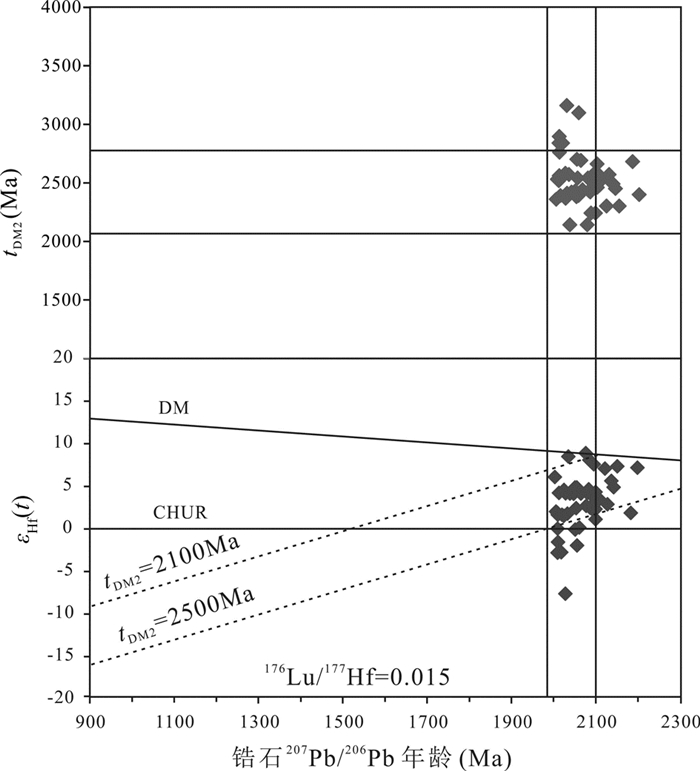
|
图 9 华北克拉通西部板块北缘中新元古代沉积物(化德群和白云鄂博群)中2000~2100Ma碎屑锆石age- εHf(t)与age-tDM2图解 数据来自Liu et al., 2014;Zhou et al., 2018.亏损地幔、球粒陨石及平均地壳演化线据Bitchert-Toft and Albarède, 1997;Griffin et al., 2000, 2002 Fig. 9 The age vs. εHf(t) and age vs. tDM2 diagrams for the 2000~2100Ma detrital zircons from the Meso-Neoproterozoic strata in northern western block of North China Craton Data from Liu et al., 2014; Zhou et al., 2018. The evolution lines of DM, CHUR and average crust are after Bitchert-Toft and Albarède, 1997;Griffin et al., 2000, 2002 |
本文对白云鄂博群尖山组进行了碎屑锆石U-Pb年代学和原位Hf同位素分析,并对尖山组沉积时限、物源以及华北克拉通西部北缘的前寒武纪地壳演化进行了探讨,主要得出以下结论:
(1) 白云鄂博群尖山组1个样品给出的谐和线上最年轻一组锆石的加权平均年龄为1794±73Ma(n=2,MSWD=0.016)。结合前人发表的年代学结果,将白云鄂博群尖山组沉积时间限定在1800~1650Ma之间;
(2) 通过对比区域上发育的岩浆以及变质事件,认为尖山组的碎屑物质主要来自于固阳、西乌兰不浪地区新太古代基底以及大青山和卓资地区古元古代晚期孔兹岩带;
(3) 华北克拉通经历了~2500Ma和2600~2750Ma两个主要的地壳生长期,同时在2000~2100Ma可能还有一次地壳生长事件,但规模相对前两次较小。
致谢 感谢天津地质调查中心王惠初研究员和中山大学地球科学与工程学院刘锦博士后两位审稿人对本文提出的宝贵意见!谨以此文祝贺杨振升先生90华诞暨从事地质事业70周年!
Amelin Y, Lee DC, Halliday AN and Pidgeon RT. 1999. Nature of the Earth's earliest crust from hafnium isotopes in single detrital zircons. Nature, 399(6733): 252-255 DOI:10.1038/20426 |
Andersen T. 2002. Correction of common lead in U-Pb analyses that do not report 204Pb. Chemical Geology, 192(1-2): 59-79 DOI:10.1016/S0009-2541(02)00195-X |
Bateman R, Costa S, Swe T and Lambert D. 2001. Archaean mafic magmatism in the Kalgoorlie area of the Yilgarn Craton, Western Australia:A geochemical and Nd isotopic study of the petrogenetic and tectonic evolution of a greenstone belt. Precambrian Research, 108(1-2): 75-112 DOI:10.1016/S0301-9268(00)00148-0 |
Beakhouse GP, Heaman LM and Creaser RA. 1999. Geochemical and U-Pb zircon geochronological constraints on the development of a Late Archean greenstone belt at Birch Lake, Superior Province, Canada. Precambrian Research, 97(1-2): 77-97 DOI:10.1016/S0301-9268(99)00021-2 |
Bibikova E, Skiöld T, Bogdanova S, Gorbatschev R and Slabunov A. 2001. Titanite-rutile thermochronometry across the boundary between the Archaean Craton in Karelia and the Belomorian Mobile Belt, eastern Baltic Shield. Precambrian Research, 105(2-4): 315-330 DOI:10.1016/S0301-9268(00)00117-0 |
Bibikova EV, Petrova A and Claesson S. 2005. The temporal evolution of sanukitoids in the Karelian Craton, Baltic Shield:An ion microprobe U-Th-Pb isotopice temporal evolution of sanukitoids in the Karelian Craton, Baltic Shield:An ion microprobe study of zircons. Lithos, 79(1-2): 129-145 DOI:10.1016/j.lithos.2004.05.005 |
Blake TS. 2001. Cyclic continental mafic tuff and flood basalt volcanism in the Late Archaean Nullagine and Mount Jope supersequences in the eastern Pilbara, Western Australia. Precambrian Research, 107(3-4): 139-177 DOI:10.1016/S0301-9268(00)00135-2 |
Blichert-Toft J and Albarède F. 1997. The Lu-Hf isotope geochemistry of chondrites and the evolution of the mantle-crust system. Earth and Planetary Science Letters, 148(1): 243-258 |
Bureau of Geology and Mineral Resources of Inner Mongolia Autonomous Region. 1991. Regional Geology of Nei Mongol (Inner Mongolia) Autonomous Region. Beijing: Geological Publishing House, 45-57 (in Chinese)
|
Cai J, Liu FL and Liu PH. 2017. Paleoproterozoic multistage metamorphic events in Jining metapelitic rocks from the Khondalite Belt in the North China Craton:Evidence from petrology, phase equilibria modelling and U-Pb geochronology. Journal of Asian Earth Sciences, 138: 515-534 DOI:10.1016/j.jseaes.2017.02.034 |
Chu NC, Taylor RN, Chavagnac V, Nesbitt RW, Boella RM, Milton JA, German CR, Bayon G and Burton K. 2002. Hf isotope ratio analysis using multi-collector inductively coupled plasma mass spectrometry:An evaluation of isobaric interference corrections. Journal of Analytical Atomic Spectrometry, 17(12): 1567-1574 DOI:10.1039/b206707b |
Condie KC. 1998. Episodic continental growth and supercontinents:A mantle avalanche connection?. Earth and Planetary Science Letters, 163(1-4): 97-108 DOI:10.1016/S0012-821X(98)00178-2 |
Condie KC. 2000. Episodic continental growth models:Afterthoughts and extensions. Tectonophysics, 322(1-2): 153-162 DOI:10.1016/S0040-1951(00)00061-5 |
Dong XJ, Xu ZY, Liu ZH and Sha Q. 2012. Zircon U-Pb geochronology of Archean high-grade metamorphic rocks from Xi Ulanbulang area, central Inner Mongolia. Science China (Earth Sciences), 55(2): 204-212 DOI:10.1007/s11430-011-4360-5 |
Dong XJ, Xu ZY, Liu ZH and Sha Q. 2012. 2.7Ga granitic gneiss in the northern foot of Daqingshan Mountain, central Inner Mongolia, and its geological implications.. Earth Science (Journal of China University of Geosciences), 37(Suppl.1): 20-27 (in Chinese with English abstract) |
Eggins SM, Kinsley LPJ and Shelley JMG. 1998. Deposition and element fractionation processes during atmospheric pressure laser sampling for analysis by ICP-MS. Applied Surface Science, 127-129: 278-286 DOI:10.1016/S0169-4332(97)00643-0 |
Fedo CM, Sircombe KN and Rainbird RH. 2003. Detrital zircon analysis of the sedimentary record. Reviews in Mineralogy & Geochemistry, 53(1): 277-303 |
Geng JZ, Li HK, Zhang J, Zhou HY and Li HM. 2011. Zircon Hf isotope analysis by means of LA-MC-ICP-MS. Geological Bulletin of China, 30(10): 1508-1513 (in Chinese with English abstract) |
Gerdes A and Zeh A. 2006. Combined U-Pb and Hf isotope LA-(MC-)ICP-MS analyses of detrital zircons:Comparison with SHRIMP and new constraints for the provenance and age of an Armorican metasediment in Central Germany. Earth and Planetary Science Letters, 249(1-2): 47-61 DOI:10.1016/j.epsl.2006.06.039 |
Gong WB, Hu JM, Li ZH, Dong XP, Liu Y and Liu SC. 2016. Detrital zircon U-Pb dating of Zhaertai Group in the North Margin Rift Zone of North China Craton and its implications. Acta Petrologica Sinica, 32(7): 2151-2165 (in Chinese with English abstract) |
Griffin WL, Pearson NJ, Belousova E, Jackson SE, van Achterbergh E, O'Reilly SY and Shee SR. 2000. The Hf isotope composition of cratonic mantle:LAM-MC-ICPMS analysis of zircon megacrysts in kimberlites. Geochimica et Cosmochimica Acta, 64(1): 133-147 DOI:10.1016/S0016-7037(99)00343-9 |
Griffin WL, Wang X, Jackson SE, Pearson NJ, O'Reilly SY, Xu X and Zhou X. 2002. Zircon chemistry and magma mixing, SE China:In-situ analysis of Hf isotopes, Tonglu and Pingtan igneous complexes. Lithos, 61(3): 237-269 |
Halla J. 2005. Late Archean high-Mg granitoids (sanukitoids) in the southern Karelian domain, eastern Finland:Pb and Nd isotopic constraints on crust-mantle interactions. Lithos, 79(1-2): 161-178 DOI:10.1016/j.lithos.2004.05.007 |
Hawkesworth CJ and Kemp AIS. 2006. Using hafnium and oxygen isotopes in zircons to unravel the record of crustal evolution. Chemical Geology, 226(3-4): 144-162 DOI:10.1016/j.chemgeo.2005.09.018 |
Hofmann A, Dirks PHGM and Jelsma HA. 2004. Clastic sedimentation in a Late Archaean accretionary terrain, Midlands greenstone belt, Zimbabwe. Precambrian Research, 129(1-2): 47-69 DOI:10.1016/j.precamres.2003.09.017 |
Hu B, Zhai MG, Guo JH, Peng P, Liu F and Liu S. 2009. LA-ICP-MS U-Pb geochronology of detrital zircons from the Huade Group in the northern margin of the North China Craton and its tectonic significance. Acta Petrologica Sinica, 25(1): 193-211 (in Chinese with English abstract) |
Hu JM, Gong WB, Wu SJ, Liu Y and Liu SC. 2014. LA-ICP-MS zircon U-Pb dating of the Langshan Group in the northeast margin of the Alxa block, with tectonic implications. Precambrian Research, 255: 756-770 DOI:10.1016/j.precamres.2014.08.013 |
Hu JM, Gong WB, Zhao Y, Zhang SH, Wu SJ, Qu HJ, Li ZH and Liang X. 2015. The confirmation of the Neoproterozoic Langshan Group in Inner Mongolia and its significance. Acta Geologica Sinica, 89(1): 318-319 DOI:10.1111/1755-6724.12422 |
Jackson SE, Pearson NJ, Griffin WL and Belousova EA. 2004. The application of laser ablation-inductively coupled plasma-mass spectrometry to in situ U-Pb zircon geochronology. Chemical Geology, 211(1-2): 47-69 DOI:10.1016/j.chemgeo.2004.06.017 |
Jiao SJ, Guo JH, Harley SL and Peng P. 2013. Geochronology and trace element geochemistry of zircon, monazite and garnet from the garnetite and/or associated other high-grade rocks:Implications for Palaeoproterozoic tectonothermal evolution of the Khondalite Belt, North China Craton. Precambrian Research, 237: 78-100 DOI:10.1016/j.precamres.2013.09.008 |
Kröner A, Jaeckel P, Brandl G, Nemchin AA and Pidgeon RT. 1999. Single zircon ages for granitoid gneisses in the Central Zone of the Limpopo Belt, Southern Africa and geodynamic significance. Precambrian Research, 93(4): 299-337 DOI:10.1016/S0301-9268(98)00102-8 |
Li CH, Liu ZH, Xu ZY, Dong XJ, Li PC, Shi Q and Wang SJ. 2019a. Detrital zircon U-Pb geochronology and provenance of Bayan Obo Group, northern margin of North China Craton:New implications for the position of NCC in Rodinia. Acta Geologica Sinica, 93(5): 1397-1416 DOI:10.1111/1755-6724.14354 |
Li HK, Lu SN, Su WB, Xiang ZQ, Zhou HY and Zhang YQ. 2013. Recent advances in the study of the Mesoproterozoic geochronology in the North China Craton. Journal of Asian Earth Sciences, 72: 216-227 DOI:10.1016/j.jseaes.2013.02.020 |
Li PC, Guo W, Guan QB and Liu JX. 2016. Late Neoarchean crustal growth in the northeast of the North China Craton:Evidence from the geochronology and Hf isotope composition of Banshigou supracrustal rocks. Acta Petrologica Sinica, 32(9): 2839-2855 (in Chinese with English abstract) |
Li PC, Dong XJ, Liu ZH, Zhao QY, Shi Q, Li CH and Li TY. 2018. Petrogenesis and tectonic implication of the mafic dykes and its host TTG gneisses from Tianqiao area in southern Jilin Province. Acta Petrologica Sinica, 34(6): 1581-1598 (in Chinese with English abstract) |
Li QL, Chen FK, Guo JH, Li XH, Yang YH and Siebel W. 2007. Zircon ages and Nd-Hf isotopic composition of the Zhaertai Group (Inner Mongolia):Evidence for Early Proterozoic evolution of the northern North China Craton. Journal of Asian Earth Sciences, 30(3-4): 573-590 DOI:10.1016/j.jseaes.2007.01.006 |
Li Z, Meng E, Wang CY and Li YG. 2019b. Early Precambrian tectono-thermal events in Southern Jilin Province, China:Implications for the evolution of Neoarchean to Paleoproterozoic crust in the northeastern North China Craton. Mineralogy and Petrology, 113(2): 185-205 DOI:10.1007/s00710-018-0649-9 |
Liu CH, Zhao GC and Liu FL. 2014. Detrital zircon U-Pb, Hf isotopes, detrital rutile and whole-rock geochemistry of the Huade Group on the northern margin of the North China Craton:Implications on the breakup of the Columbia supercontinent. Precambrian Research, 254: 290-305 DOI:10.1016/j.precamres.2014.09.011 |
Liu CH and Liu FL. 2015. The Mesoproterozoic rifting in the North China Craton:A case study for magmatism and sedimentation of the Zhaertai-Bayan Obo-Huade rift zone. Acta Petrologica Sinica, 31(10): 3107-3128 (in Chinese with English abstract) |
Liu CH, Zhao GC, Liu FL and Shi JR. 2017a. Detrital zircon U-Pb and Hf isotopic and whole-rock geochemical study of the Bayan Obo Group, northern margin of the North China Craton:Implications for Rodinia reconstruction. Precambrian Research, 303: 372-391 DOI:10.1016/j.precamres.2017.04.033 |
Liu DY, Nutman AP, Compston W, Wu JS and Shen QH. 1992. Remnants of ≥ 3800Ma crust in the Chinese part of the Sino-Korean Craton. Geology, 20(4): 339-342 DOI:10.1130/0091-7613(1992)020<0339:ROMCIT>2.3.CO;2 |
Liu J, Liu ZH, Zhao C, Wang CJ, Peng YB and Zhang H. 2017b. Petrogenesis and zircon LA-ICP-MS U-Pb dating of newly discovered Mesoarchean gneisses on the northern margin of the North China Craton. International Geology Review, 59(12): 1575-1589 DOI:10.1080/00206814.2017.1285729 |
Liu J, Zhang J, Liu ZH, Yin CQ, Zhao C, Peng YB, Dou SY and Yang ZJ. 2018a. Geochemistry, geochronology, and Hf isotopic composition of the Late Paleoproterozoic Lujiapuzi Formation, NE Yan-Liao Rift, northern Liaoning. Acta Geologica Sinica, 92(6): 2136-2156 |
Liu JH, Liu FL, Ding ZJ, Liu PH, Chen JQ, Liu CH, Wang F, Yang H, Cai J and Shi JR. 2017c. Late Neoarchean-Paleoproterozoic arc-continent accretion along the Khondalite Belt, Western Block, North China Craton:Insights from granitoid rocks of the Daqingshan-Wulashan area. Precambrian Research, 303: 494-519 DOI:10.1016/j.precamres.2017.06.006 |
Liu XG, Li SZ, Li XY, Zhao SJ, Wang TS, Yu SY, Dai LM, Zhou ZZ and Guo RH. 2018b. Detrital zircon U-Pb geochronology and provenance of the Sanxiatian Formation (Huade Group) in the North China Craton:Implications for the breakup of the Columbia supercontinent. Precambrian Research, 310: 305-319 DOI:10.1016/j.precamres.2018.02.006 |
Liu YS, Hu ZC, Zong KQ, Gao CG, Gao S, Xu J and Chen HH. 2010. Reappraisement and refinement of zircon U-Pb isotope and trace element analyses by LA-ICP-MS. Chinese Science Bulletin, 55(15): 1535-1546 DOI:10.1007/s11434-010-3052-4 |
Lu SN, Yang CL, Li HK and Li HM. 2002. A group of rifting events in the terminal Paleoproterozoic in the North China Craton. Gondwana Research, 5(1): 123-131 DOI:10.1016/S1342-937X(05)70896-0 |
Lu SN, Zhao GC, Wang HC and Hao GJ. 2008. Precambrian metamorphic basement and sedimentary cover of the North China Craton:A review. Precambrian Research, 160(1-2): 77-93 DOI:10.1016/j.precamres.2007.04.017 |
Ma MZ, Zhang YX, Xie HQ and Wan YS. 2014. SHRIMP U-Pb dating and LA-ICP-MS Hf isotope analysis of detrital zircons from medium-to coarse-grained sandstones of the Bayan Obo Group and Sailinhudong Group and its geological significances. Acta Petrologica Sinica, 30(10): 2973-2988 (in Chinese with English abstract) |
Ma MZ, Dong CY, Xu ZY, Xie SW, Liu DY and Wan YS. 2015. Anatexis of Early Paleoproterozoic garnet-biotite gneisses (Daqingshan supracrustal rocks) in Daqingshan, Inner Mongolia:Geology, zircon geochronology and geochemistry. Acta Petrologica Sinica, 31(6): 1535-1548 (in Chinese with English abstract) |
Ma XD, Guo JH, Liu F, Qian Q and Fan HR. 2013. Zircon U-Pb ages, trace elements and Nd-Hf isotopic geochemistry of Guyang sanukitoids and related rocks:Implications for the Archean crustal evolution of the Yinshan Block, North China Craton. Precambrian Research, 230: 61-78 DOI:10.1016/j.precamres.2013.02.001 |
Ma XD, Fan HR, Santosh M and Guo JH. 2014. Chronology and geochemistry of Neoarchean BIF-type iron deposits in the Yinshan Block, North China Craton:Implications for oceanic ridge subduction. Ore Geology Reviews, 63: 405-417 DOI:10.1016/j.oregeorev.2014.02.010 |
Ma XD and Zhong Y. 2018. Geochemistry and chronology of a diorite pluton in the Yinshan Block:Implications for crustal growth and evolution of North China Craton. Geological Journal, 53(6): 2849-2862 DOI:10.1002/gj.3124 |
Matteini M, Dantas EL, Pimentel MM, de Alvarenga CJS and Dardenne MA. 2012. U-Pb and Hf isotope study on detrital zircons from the Paranoá Group, Brasília Belt Brazil:Constraints on depositional age at Mesoproterozoic-Neoproterozoic transition and tectono-magmatic events in the São Francisco craton. Precambrian Research, 206-207: 168-181 DOI:10.1016/j.precamres.2012.03.007 |
McCulloch MT and Bennett VC. 1994. Progressive growth of the Earth's continental crust and depleted mantle:Geochemical constraints. Geochimica et Cosmochimica Acta, 58(21): 4717-4738 DOI:10.1016/0016-7037(94)90203-8 |
Mortensen JK. 1993a. U-Pb geochronology of the eastern Abitibi Subprovince. Part 1:Chibougamau-Matagami-Joutel region. Canadian Journal of Earth Sciences, 30(1): 11-28 DOI:10.1139/e93-002 |
Mortensen JK. 1993b. U-Pb geochronology of the eastern Abitibi Subprovince. Part 2:Noranda-Kirkland Lake area. Canadian Journal of Earth Sciences, 30(1): 29-41 DOI:10.1139/e93-003 |
Patchett PJ and Tatsumoto M. 1981. A routine high-precision method for Lu-Hf isotope geochemistry and chronology. Contributions to Mineralogy and Petrology, 75(3): 263-267 DOI:10.1007/BF01166766 |
Peng P, Zhai MG, Guo JH, Kusky T and Zhao TP. 2007. Nature of mantle source contributions and crystal differentiation in the petrogenesis of the 1.78Ga mafic dykes in the central North China Craton. Gondwana Research, 12(1-2): 29-46 DOI:10.1016/j.gr.2006.10.022 |
Peng P. 2015. Precambrian mafic dyke swarms in the North China Craton and their geological implications. Science China (Earth Sciences), 58(5): 649-675 DOI:10.1007/s11430-014-5026-x |
Percival JA, Stern RA and Skulski T. 2001. Crustal growth through successive arc magmatism:Reconnaissance U-Pb SHRIMP data from the northeastern Superior Province, Canada. Precambrian Research, 109(3-4): 203-238 DOI:10.1016/S0301-9268(01)00148-6 |
Percival JA and Helmstaedt H. 2004. Insights on Archean continent-ocean assembly, western Superior Province, from new structural, geochemical and geochronological observations:Introduction and summary. Precambrian Research, 132(3): 209-212 DOI:10.1016/j.precamres.2003.11.006 |
Poujol M, Robb LJ, Anhaeusser CR and Gericke B. 2003. A review of the geochronological constraints on the evolution of the Kaapvaal Craton, South Africa. Precambrian Research, 127(1-3): 181-213 DOI:10.1016/S0301-9268(03)00187-6 |
Priyatkina N, Ernst RE and Khudoley AK. 2020. A preliminary reassessment of the Siberian cratonic basement with new U-Pb-Hf detrital zircon data. Precambrian Research, 340: 105645 DOI:10.1016/j.precamres.2020.105645 |
Ren P, Xie HQ, Wang SJ, Dong CY, Ma MZ, Liu DY and Wan YS. 2015. 2.5~2.7Ga tectono-thermal events in western Shandong:Geology and zircon SHRIMP dating of TTG rocks in Huangqian Reservoir, Taishan Mountain. Geological Review, 61(5): 1068-1078 (in Chinese with English abstract) |
Samsonov AV, Bogina MM, Bibikova EV, Petrova AY and Shchipansky AA. 2005. The relationship between adakitic, calc-alkaline volcanic rocks and TTGs:Implications for the tectonic setting of the Karelian greenstone belts, Baltic Shield. Lithos, 79(1-2): 83-106 DOI:10.1016/j.lithos.2004.04.051 |
Sandeman HA, Hanmer S, Tella S, Armitage AA, Davis WJ and Ryan JJ. 2006. Petrogenesis of Neoarchaean volcanic rocks of the MacQuoid supracrustal belt:A back-arc setting for the northwestern Hearne subdomain, western Churchill Province, Canada. Precambrian Research, 144(1-2): 140-165 DOI:10.1016/j.precamres.2005.11.001 |
Santosh M, Wilde SA and Li JH. 2007. Timing of Paleoproterozoic ultrahigh-temperature metamorphism in the North China Craton:Evidence from SHRIMP U-Pb zircon geochronology. Precambrian Research, 159(3-4): 178-196 DOI:10.1016/j.precamres.2007.06.006 |
Song HX, Yang CH, Du LL, Ren LD and Geng YS. 2018. Delineation of the ~2.7Ga TTG gneisses in Zanhuang Complex, Hebei Province, and its geological significance. Acta Petrologica Sinica, 34(6): 1599-1611 (in Chinese with English abstract) |
Steenfelt A, Garde AA and Moyen JF. 2005. Mantle wedge involvement in the petrogenesis of Archaean grey gneisses in West Greenland. Lithos, 79(1-2): 207-228 DOI:10.1016/j.lithos.2004.04.054 |
Sun SF. 1992. The new discovery of fossil microplants in the Jianshan Formation of the Bayan Obo Group, Inner Mongolia. Geological Review, 38(5): 474-480 (in Chinese with English abstract) |
Tan LK and Shi TZ. 2000. Discovery and significance of small shelly fossils in the Bayan Obo Group in Shangdu, Inner Mongolia. Geological Review, 46(6): 573-583 (in Chinese with English abstract) |
Thrane K. 2002. Relationships between Archaean and Palaeoproterozoic crystalline basement complexes in the southern part of the East Greenland Caledonides:An ion microprobe study. Precambrian Research, 113(1-2): 19-42 DOI:10.1016/S0301-9268(01)00198-X |
Wan YS, Liu DY, Dong CY, Nutman A, Wilde SA, Wang W, Xie HQ, Yin XY and Zhou HY. 2009. The oldest rocks and zircons in China. Acta Petrologica Sinica, 25(8): 1793-1807 (in Chinese with English abstract) |
Wan YS, Liu DY, Wang W, Song TR, Kröner A, Dong CY, Zhou HY and Yin XY. 2011. Provenance of Meso-to Neoproterozoic cover sediments at the Ming Tombs, Beijing, North China Craton:An integrated study of U-Pb dating and Hf isotopic measurement of detrital zircons and whole-rock geochemistry. Gondwana Research, 20(1): 219-242 DOI:10.1016/j.gr.2011.02.009 |
Wan YS, Xie SW, Yang CH, Kröner A, Ma MZ, Dong CY, Du LL, Xie HQ and Liu DY. 2014. Early Neoarchean (~2.7Ga) tectono-thermal events in the North China Craton:A synthesis. Precambrian Research, 247: 45-63 DOI:10.1016/j.precamres.2014.03.019 |
Wang D, Guo JH, Huang GY and Scheltens M. 2015. The Neoarchean ultramafic-mafic complex in the Yinshan Block, North China Craton:Magmatic monitor of development of Archean lithospheric mantle. Precambrian Research, 270: 80-99 DOI:10.1016/j.precamres.2015.09.002 |
Wang F, Liu FL, Schertl HP, Xu W, Liu PH and Tian ZH. 2020. Detrital zircon U-Pb geochronology and Hf isotopes of the Liaohe Group, Jiao-Liao-Ji Belt:Implications for the Paleoproterozoic tectonic evolution. Precambrian Research, 340: 105633 DOI:10.1016/j.precamres.2020.105633 |
Wang X, Li XP and Han ZZ. 2018. Zircon ages and geochemistry of amphibolitic rocks from the Paleoproterozoic Erdaowa Group in the Khondalite Belt, North China Craton and their tectonic implications. Precambrian Research, 317: 253-267 DOI:10.1016/j.precamres.2018.09.005 |
Wu FY, Zhang YB, Yang JH, Xie LW and Yang YH. 2008. Zircon U-Pb and Hf isotopic constraints on the Early Archean crustal evolution in Anshan of the North China Craton. Precambrian Research, 167(3-4): 339-362 DOI:10.1016/j.precamres.2008.10.002 |
Xia XP, Sun M, Zhao GC and Luo Y. 2006. LA-ICP-MS U-Pb geochronology of detrital zircons from the Jining Complex, North China Craton and its tectonic significance. Precambrian Research, 144(3-4): 199-212 DOI:10.1016/j.precamres.2005.11.004 |
Xia XP, Sun M, Zhao GC, Wu FY, Xu P, Zhang J and He YH. 2008. Paleoproterozoic crustal growth in the Western Block of the North China Craton:Evidence from detrital zircon Hf and whole rock Sr-Nd isotopic compositions of the Khondalites from the Jining Complex. American Journal of Science, 308(3): 304-327 DOI:10.2475/03.2008.05 |
Xiao LL, Liu FL and Zhang J. 2019. Response to the Early Neoarchean tectono-thermal events in the North China Craton:Evidence of ca. 2.7Ga TTG gneisses from the Zuoquan metamorphic complex. Acta Petrologica Sinica, 35(2): 325-348 (in Chinese with English abstract) DOI:10.18654/1000-0569/2019.02.04 |
Xu ZY, Wan YS, Dong CY, Ma MZ and Liu DY. 2015. Late Neoarchean magmatism identified in Daqingshan, Inner Mongolia:SHRIMP zircon U-Pb dating. Acta Petrologica Sinica, 31(6): 1509-1517 (in Chinese with English abstract) |
Yang KF, Fan HR, Hu FF and Wang KY. 2012. Sediment source of Bayan Obo marginal rift and genesis of ore-bearing dolomite of the giant REE deposit. Acta Geologica Sinica, 86(5): 775-784 (in Chinese with English abstract) |
Yuan HL, Gao S, Liu XM, Li HM, Günther D and Wu FY. 2004. Accurate U-Pb age and trace element determinations of zircon by laser ablation-inductively coupled plasma-mass spectrometry. Geostandards and Geoanalytical Research, 28(3): 353-370 DOI:10.1111/j.1751-908X.2004.tb00755.x |
Zeh A, Gerdes A, Klemd R and Barton JM. 2007. Archaean to Proterozoic crustal evolution in the Central Zone of the Limpopo Belt (South Africa-Botswana):Constraints from combined U-Pb and Lu-Hf isotope analyses of zircon. Journal of Petrology, 48(8): 1605-1639 DOI:10.1093/petrology/egm032 |
Zhai MG, Bian AG and Zhao TP. 2000. The amalgamation of the supercontinent of North China Craton at the end of Neo-Archaean and its breakup during Late Palaeoproterozoic and Meso-Proterozoic. Science in China (Series D), 43(S1): 219-232 DOI:10.1007/BF02911947 |
Zhai MG and Liu WJ. 2003. Palaeoproterozoic tectonic history of the North China Craton:A review. Precambrian Research, 122(1-4): 183-199 DOI:10.1016/S0301-9268(02)00211-5 |
Zhai MG. 2011. Cratonization and the Ancient North China Continent:A summary and review. Science China (Earth Sciences), 54(8): 1110-1120 DOI:10.1007/s11430-011-4250-x |
Zhai MG and Santosh M. 2011. The Early Precambrian Odyssey of the North China Craton:A synoptic overview. Gondwana Research, 20(1): 6-25 DOI:10.1016/j.gr.2011.02.005 |
Zhai MG. 2013. The main old lands in China and assembly of Chinese unified continent. Science China (Earth Sciences), 56(11): 1829-1852 DOI:10.1007/s11430-013-4665-7 |
Zhai MG. 2014. Multi-stage crustal growth and cratonization of the North China Craton. Geoscience Frontiers, 5(4): 457-469 DOI:10.1016/j.gsf.2014.01.003 |
Zhai MG, Hu B, Zhao TP, Peng P and Meng QR. 2015. Late Paleoproterozoic-Neoproterozoic multi-rifting events in the North China Craton and their geological significance:A study advance and review. Tectonophysics, 662: 153-166 DOI:10.1016/j.tecto.2015.01.019 |
Zhang SH, Liu SW, Zhao Y, Yang JH, Song B and Liu XM. 2007. The 1.75~1.68Ga anorthosite-mangerite-alkali granitoid-rapakivi granite suite from the northern North China Craton:Magmatism related to a Paleoproterozoic orogen. Precambrian Research, 155(3-4): 287-312 DOI:10.1016/j.precamres.2007.02.008 |
Zhang XH, Yuan LL, Xue FH and Zhai MG. 2014. Neoarchean metagabbro and charnockite in the Yinshan block, western North China Craton:Petrogenesis and tectonic implications. Precambrian Research, 255: 563-582 DOI:10.1016/j.precamres.2013.11.003 |
Zhao GC, Wilde SA, Cawood PA and Lu LZ. 2000. Petrology and P-T path of the Fuping mafic granulites:Implications for tectonic evolution of the central zone of the North China Craton. Journal of Metamorphic Geology, 18(4): 375-391 DOI:10.1046/j.1525-1314.2000.00264.x |
Zhao GC, Sun M, Wilde SA and Li SZ. 2003. Assembly, accretion and breakup of the Paleo-Mesoproterozoic Columbia Supercontinent:Records in the North China Craton. Gondwana Research, 6(3): 417-434 DOI:10.1016/S1342-937X(05)70996-5 |
Zhao GC, Sun M, Wilde SA and Li SZ. 2004. A Paleo-Mesoproterozoic supercontinent:Assembly, growth and breakup. Earth-Science Reviews, 67(1-2): 91-123 DOI:10.1016/j.earscirev.2004.02.003 |
Zhao GC, Sun M, Wilde SA, Li SZ, Liu SW and Zhang J. 2006. Composite nature of the North China granulite-facies belt:Tectonothermal and geochronological constraints. Gondwana Research, 9(3): 337-348 DOI:10.1016/j.gr.2005.10.004 |
Zhao GC, Wilde SA, Sun M, Li SZ, Li XP and Zhang J. 2008. SHRIMP U-Pb zircon ages of granitoid rocks in the Lüliang Complex:Implications for the accretion and evolution of the Trans-North China Orogen. Precambrian Research, 160(3-4): 213-226 DOI:10.1016/j.precamres.2007.07.004 |
Zhao GC, Li SZ, Sun M and Wilde SA. 2011. Assembly, accretion, and break-up of the Palaeo-Mesoproterozoic Columbia Supercontinent:Record in the North China Craton revisited. International Geology Review, 53(11-12): 1331-1356 DOI:10.1080/00206814.2010.527631 |
Zhao GC, Cawood PA, Li SZ, Wilde SA, Sun M, Zhang J, He YH and Yin CQ. 2012. Amalgamation of the North China Craton:Key issues and discussion. Precambrian Research, 222-223: 55-76 DOI:10.1016/j.precamres.2012.09.016 |
Zhao TP, Chen FK, Zhai MG and Xia B. 2004. Single zircon U-Pb ages and their geological significance of the Damiao anorthosite complex, Hebei Province, China. Acta Petrologica Sinica, 20(3): 685-690 (in Chinese with English abstract) |
Zhao TP, Xu YH and Zhai MG. 2007. Petrogenesis and tectonic setting of the Paleoproterozoic Xiong'er Group in the southern part of the North China Craton:A review. Geological Journal of China Universities, 13(2): 191-206 (in Chinese with English abstract) |
Zhao TP and Zhou MF. 2009. Geochemical constraints on the tectonic setting of Paleoproterozoic A-type granites in the southern margin of the North China Craton. Journal of Asian Earth Sciences, 36(2-3): 183-195 DOI:10.1016/j.jseaes.2009.05.005 |
Zhong Y, Zhai MG, Peng P, Santosh M and Ma XD. 2015. Detrital zircon U-Pb dating and whole-rock geochemistry from the clastic rocks in the northern marginal basin of the North China Craton:Constraints on depositional age and provenance of the Bayan Obo Group. Precambrian Research, 258: 133-145 DOI:10.1016/j.precamres.2014.12.010 |
Zhou ZG, Wang GS, Zhang D, Gu YC, Zhu WP, Liu CF, Zhao XQ and Hu MM. 2016. Zircon ages of gabbros in the Siziwangqi, Inner Mongolia and its constrain on the formation time of the Bayan Obo Group. Acta Petrologica Sinica, 32(6): 1809-1822 (in Chinese with English abstract) |
Zhou ZG, Hu MM, Wu C, Wang GS, Liu CF, Cai AR and Jiang T. 2018. Coupled U-Pb dating and Hf isotopic analysis of detrital zircons from Bayan Obo Group in Inner Mongolia:Constraints on the evolution of the Bayan Obo rift belt. Geological Journal, 53(6): 2649-2664 DOI:10.1002/gj.3102 |
董晓杰, 徐仲元, 刘正宏, 沙茜. 2012. 内蒙古大青山北麓2.7Ga花岗质片麻岩的发现及其地质意义. 地球科学(中国地质大学学报), 37(增1): 20-27. |
耿建珍, 李怀坤, 张健, 周红英, 李惠民. 2011. 锆石Hf同位素组成的LA-MC-ICP-MS测定. 地质通报: 1508-1513. |
公王斌, 胡健民, 李振宏, 董晓朋, 刘洋, 刘绍昌. 2016. 华北克拉通北缘裂谷渣尔泰群LA-ICP-MS碎屑锆石U-Pb测年及地质意义. 岩石学报, 32(7): 2151-2165. |
胡波, 翟明国, 郭敬辉, 彭澎, 刘富, 刘爽. 2009. 华北克拉通北缘化德群中碎屑锆石的LA-ICP-MSU-Pb年龄及其构造意义. 岩石学报, 25(1): 193-211. |
李鹏川, 郭巍, 关庆彬, 刘杰勋. 2016. 华北克拉通东北部新太古代晚期地壳生长:来自板石沟表壳岩年代学和Hf同位素的证据. 岩石学报, 32(9): 2839-2855. |
李鹏川, 董晓杰, 刘正宏, 赵庆英, 石强, 李长海, 李天瑜. 2018. 吉南天桥地区基性岩墙与其围岩TTG片麻岩的成因及构造意义. 岩石学报, 34(6): 1581-1598. |
刘超辉, 刘福来. 2015. 华北克拉通中元古代裂解事件:以渣尔泰-白云鄂博-化德裂谷带岩浆与沉积作用研究为例. 岩石学报, 31(10): 3107-3128. |
马铭株, 章雨旭, 颉颃强, 万渝生. 2014. 华北克拉通北缘白云鄂博群和腮林忽洞群底部碎屑锆石U-Pb定年、Hf同位素分析及其地质意义. 岩石学报, 30(10): 2973-2988. |
马铭株, 董春艳, 徐仲元, 谢士稳, 刘敦一, 万渝生. 2015. 内蒙古大青山地区古元古代早期榴云片麻岩(大青山表壳岩)深熔作用:地质、锆石年代学和地球化学研究. 岩石学报, 31(6): 1535-1548. |
内蒙古自治区地质矿产局. 1991. 内蒙古自治区区域地质志. 北京: 地质出版社, 45-57.
|
任鹏, 颉颃强, 王世进, 董春艳, 马铭株, 刘敦一, 万渝生. 2015. 鲁西2.5~2.7Ga构造岩浆热事件:泰山黄前水库TTG侵入岩的野外地质和锆石SHRIMP定年. 地质论评, 61(5): 1068-1078. |
宋会侠, 杨崇辉, 杜利林, 任留东, 耿元生. 2018. 河北赞皇杂岩中2.7Ga TTG片麻岩的厘定及其地质意义. 岩石学报, 34(6): 1599-1611. |
孙淑芬. 1992. 内蒙古白云鄂博群尖山组微古植物新发现. 地质论评, 38(5): 474-480. |
谭励可, 石铁铮. 2000. 内蒙古商都白云鄂博群小壳化石的发现及其意义. 地质论评, 46(6): 573-583. |
万渝生, 刘敦一, 董春艳, Nutman A, Wilde SA, 王伟, 颉颃强, 殷小艳, 周红英. 2009. 中国最老岩石和锆石. 岩石学报, 25(8): 1793-1807. |
肖玲玲, 刘福来, 张健. 2019. 华北克拉通新太古代早期构造热事件的响应:来自左权地区ca. 2.7Ga TTG片麻岩的证据. 岩石学报, 35(2): 325-348. |
徐仲元, 万渝生, 董春艳, 马铭株, 刘敦一. 2015. 内蒙古大青山地区新太古代晚期岩浆作用:来自锆石SHRIMP U-Pb定年的证据. 岩石学报, 31(6): 1509-1517. |
杨奎峰, 范宏瑞, 胡芳芳, 王凯怡. 2012. 白云鄂博陆缘裂谷系沉积物源与超大型稀土矿床含矿白云岩的成因探讨. 地质学报, 86(5): 775-794. |
赵太平, 陈福坤, 翟明国, 夏斌. 2004. 河北大庙斜长岩杂岩体锆石U-Pb年龄及其地质意义. 岩石学报, 20(3): 685-690. |
赵太平, 徐勇航, 翟明国. 2007. 华北陆块南部元古宙熊耳群火山岩的成因与构造环境:事实与争议. 高校地质学报, 13(2): 191-206. |
周志广, 王果胜, 张达, 谷永昌, 朱卫平, 柳长峰, 赵孝旗, 胡萌萌. 2016. 内蒙古四子王旗地区侵入白云鄂博群辉长岩的年龄及其对白云鄂博群时代的约束. 岩石学报, 32(6): 1809-1822. |
 2020, Vol. 36
2020, Vol. 36


